No products in the cart.

MacBook Battery Not Charging? 11 Quick Fixes to Help You Out
The best thing about having a laptop is its portability. You can use it whenever and wherever you want without having to deal with those annoying cords. However, the workflow and mobility can be badly affected if your MacBook battery drains quickly and is not charging.
There is no need to worry if your MacBook battery is not charging. MacBook battery issues are not new and uncommon for MacBook users. Here are 11 quick and effective fixes to help you with this issue.
Why Is MacBook Battery Not Charging?
Laptop battery problems often occur more frequently in used laptops. Opting for refurbished laptops decreases the likelihood of encountering battery issues. However, there could be various reasons why your battery is not charging, whether you are using a MacBook, MacBook Pro, or MacBook Air. Let’s take a look at why your laptop battery is acting up and how to fix these issues quickly.
Physical Connections
Problem
MacBook batteries usually do not charge due to problems with physical connections. A damaged charging adapter, broken charging wire, or improper connections to the MacBook are included in poor physical connections that cause the battery to not charge.
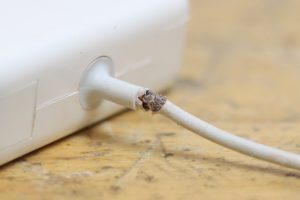
Tip
Inspect the charging cable to see if the physical connection is the culprit. If the cable is damaged, replace it with a new one. Check the power adapter and ensure that the adapter is securely connected to both the power connection and your MacBook. Sometimes, changing your power outlet can resolve the issue.
SMC (System Management Controller) Issue
Problem
When your MacBook’s system management controller is out of sync, it causes various hardware issues, including battery problems. The SMC controls important functions such as thermal management, battery charging, and keyboard backlighting. If the SMC becomes unresponsive or experiences a glitch, the charging of your laptop battery will be impacted.
Tip
Resetting SMC is an effective troubleshooting technique. If you have a laptop with a non-removable battery, such as MacBook Air or MacBook Pro, you can follow this step-by-step guide to reset it.
- Shut down your laptop.
- Press and hold the shift, control, and option keys on the left side of the keyboard, then press and hold the power button simultaneously.
- Hold these keys and the power button for 10 seconds.
- Release all keys and the power button.
- Turn on your laptop from the power button.
By resetting SMC, you allow hardware to amend the possible problem related to battery charging.

Outdated MacOS
Problem
Your MacBook battery charging can be affected if your OS is outdated. Apple regularly releases updates that address bugs to improve hardware performance and compatibility. If you have not updated your laptop and are ignoring the updates, this interferes with the operations of the MacBook battery management system.
Tip
Keeping your Mac operating system updated is essential for potential battery-draining problems. Here is how you can check your MacBook updates.
- Click on the Apple menu on the top-left of your MacBook screen.
- First, select system preferences.
- Choose software update.
- Check if updates are available click on “Update Now.”
- Allow your MacBook to install any pending updates and restart it.
This simple step ensures that your operating system is in sync with the latest updates, reducing the chances of encountering issues with MacBook battery charging. Check MacOS updates regularly to maintain your laptop’s overall health and performance.
Battery Health
Problem
MacBook batteries naturally degrade over time, affecting their capacity and health. If your laptop battery is not charging as it should, it is due to deteriorated battery health. This degradation happens due to chemical processes during charging and discharging cycles, decreasing the battery’s ability to hold charge.
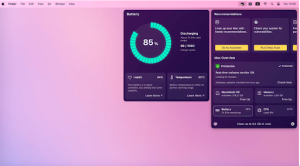
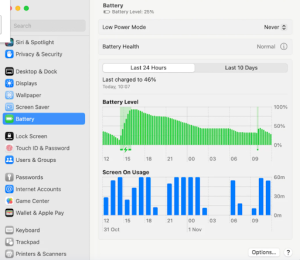
Tip
Check your battery health and troubleshoot the charging issues by following these steps.
- Click on the Apple menu in the top left corner of your screen.
- Click about this Mac
- Click on the system report.
- In the left sidebar, select power.
Here, you will find detailed information about your laptop battery. If your battery health is anything but not normal, consider replacing your MacBook battery. Check some of the most common Mac repairs and how to avoid them.
Or you can consult with an Apple service provider or an authorized shop that provides Mac repairs in Toronto or for battery replacement. Monitor your battery health to address issues early on and take preventive measures to extend the lifespan of your laptop.
Heavy Applications Issue
Problem
Running heavy applications on your MacBook affects its battery performance. These heavy applications consume significant power, leading to slower charging time and fast battery drainage. If your MacBook battery is not charging as quickly as it used to, resource-heavy apps might be the culprit.
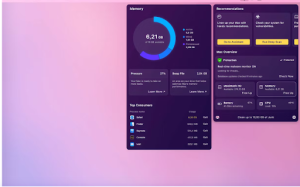
Tip
Identify and close unnecessary applications draining your MacBook’s battery to troubleshoot this issue.
- To close heavy applications, open the activity monitor.
- In the activity monitor window, click on the CPU tab. Sort the applications by CPU usage, with the highest usage at the top.
- Identify heavy applications, close them by selecting them, and click the X button in the top left corner.
By closing these heavy apps, you free up system resources, allowing the MacBook to store more power in the battery charging process. This simple step can result in a smoother and more efficient charging experience for your laptop.
Physical Damage
Problem
Physical damage to your MacBook may affect its ability to charge its battery. This includes dents, cracks, or liquid spills that might harm the internal charging components. If your MacBook had a bump with anything or had a fall, there would be visible signs of damage. This could be one of the reasons your MacBook battery is not charging.
Tip
Inspect your laptop carefully for any physical damage. Check areas around the battery, charging ports, and the overall casing. Look for professional assistance for battery replacement if you find any damage. Authorized Apple service providers better evaluate the extent of the damage and advice on whether your MacBook Air or MacBook Pro battery replacement is required. This will ensure that your laptop battery continues to perform perfectly while avoiding potential complications caused by physical damage.
Run Apple Diagnostics
Problem
If your MacBook battery faces persistent problems, it could indicate hardware issues that must be solved. In such cases, running Apple diagnostics is critical. Apple diagnostic tool can detect potential issues with your MacBook’s battery, which helps you decide whether battery replacement is essential or can be repaired.
Tip
To run Apple Diagnostics
- Shut down your MacBook
- Now turn it on and press the “D” key until the Apple diagnostics screen appears.
- Follow the instructions given on the screen for the diagnostic process to begin.
Apple diagnostic tool will check different hardware components, including the battery. If any problem with the battery is detected, the tool will provide reference codes and suggestions for further action. If you receive indications related to MacBook battery replacement or repair, contact Apple Support or visit any authorized Mac repair shop in Toronto. MacBook Pro or MacBook Air battery replacement prolongs the overall lifespan of your device.
Calibrate MacBook Battery
Problem
With time, your laptop battery develops inaccuracies in indicating its charge levels. If your laptop is showing an inaccurate battery percentage, it’s time to calibrate your MacBook battery.
Tip
Calibrating your battery helps to report its charge status accurately. Here is a step-by-step guide to calibrating the battery.
Verify the battery is properly installed by turning the laptop on without the power adaptor connected.
- Connect the adapter and charge your MacBook to 100%.
- Keep the connector plugged in for two more hours after full charge.
- Use your laptop in an energy-saving mood until it reaches a low level and sleeps.
- Let your MacBook remain asleep for at least five hours.
- Now charge it back to 100%.
Calibrating the battery ensures that the reported battery percentage aligns with the actual charge, enhancing the accuracy of your MacBook’s power management system. This simple procedure can resolve issues related to inaccurate battery readings and contribute to a more reliable MacBook Pro and MacBook Air charging experience.
Identify Software Conflict
Problem
Software conflicts impact MacBook’s battery performance, leading to problems like slow charging or sudden power drainage. Conflicts between installed applications or system processors create constrictions in power distribution. If you’re experiencing irregular charging behavior or your laptop is taking longer charging time than usual, software conflicts could be the problem.
Tip
To identify and resolve software conflicts.
- Open the activity monitor (Command + Space, type “Activity Monitor,” and press Enter).
- Navigate to the “Energy” tab.
- Sort applications by energy impact, with the highest at the top.
- Identify resource-intensive applications and consider uninstalling them.
Review recently installed applications or system updates to find the one that clashes with the charging issues. Uninstall any software that causes conflicts.
Reset PRAM
Problem
If your MacBook is not charging or charging extremely slowly, there could be an issue with PRAM (parameter RAM data). This data includes user-defined settings like screen brightness, keyboard backlight, and sound volume. If it is corrupted, it can disturb the normal charging process, leading to frustrating charging issues.
Tip
Resetting the PRAM is a quick solution if your battery is not charging. Follow these easy steps to rest your MacBook Air and MacBook Pro battery.
- Hold the power button for at least 5 seconds until your MacBook powers off.
- Press the power button to turn it back on.
- When you hear the startup sound or see any light on the screen, simultaneously hold down the Control, Option, R, and P keys.
- Keep holding these four keys until your MacBook restarts.
- Release all the keys.
Your parameter RAM data is now reset.
Loose I/O Board Cable
Problem
MacBook Air I/O cable plays an important role in communication between the logic board and the MagSafe charger through a one-wire circuit. If this one-wire circuit is loose, the signal won’t reach the charger, resulting in a lack of green light on the connector and, thus, failure to charge the MacBook Air battery.
Tip
MacBook Air has a cable connecting the logic board to the I/O board. Find this cable to proceed.
Disconnect the cable and clean both connectors on the logic board and the I/O board using a toothbrush and 95% alcohol.
When reconnecting, ensure the correct cable direction to prevent potential damage to the MacBook. A reversed connection can harm the device.
Why Consider MacBook Battery Replacement?
If your MacBook continues to face battery charging problems even after fixing all the issues that might be the cause of slow or no charging, or If the MacBook battery notification window shows “ Replace Now” or “No Battery Available,” it is time for your MacBook battery replacement.
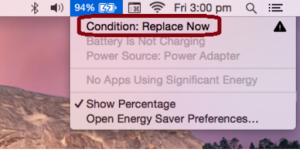
Over time, the laptop battery loses efficiency. MacBook battery replacement would be the most feasible option to restore optimal charging performance. Seek assistance from shops that offer service of Mac repairs in Toronto or an authorized Apple service provider for MacBook battery replacement, as they offer genuine Apple batteries for better compatibility and performance of your MacBook.
Conclusion
Resolving MacBook battery charging issues requires a systematical approach. You can keep your MacBook charged and its battery healthy by following these 11 quick fixes and preventative measures.
By incorporating these practices into your routine, you actively contribute to your laptop’s overall health and performance. Remember that a well-maintained device improves your experience and reduces the chances of disruptive charging issues in the future.
